Verizon, AT&T and T-Mobile's plan prices are globally high, and 5G is not to blame

The US is often pinned as an example for the world's richest country, but that record GDP is arguably built on constant overpaying for stuff that boosts the number to stratospheric heights. A $23 trillion real estate market? Check. A $3.5 trillion healthcare spending per year thanks to obscure drug and procedure pricing that overinflates them multiple times above the average in other countries? Check. The world's most expensive cell phone plan prices? Wait, what?
A recent news out of Korea stated that the country's three main carriers already have one million 5G subscribers between them. Despite Verizon's bragging that it managed to execute the first commercial 5G network connection with a phone (Moto Z3 with the respective Mod) - just a day before Korea said it will officially flip its 5G switch - the rollout in the US has been painstakingly slow.
Are Verizon, AT&T or T-Mobile's plan prices too expensive?
The good news is that Verizon doesn't charge its intended $10 per line extra for 5G connectivity, at least for now, but that doesn't mean that US plan prices are low for global standards - on the contrary. Let's have a quick look who pays what with the world's 10 largest carriers, adding some that have 5G already, and then some more for good measure, and gauge where we sit.
| Country/carrier | Monthly plan price for a single line | Monthly 5G plan price |
|---|---|---|
| Verizon (US) | $95/$85 ( 75GB/22GB at full 4G/5G speed) | same |
| AT&T (US) | $80 (22GB at full 4G speed) | for business customers |
| T-Mobile (US) | $85 (50GB at full 4G speed) | same when 5G launches later in 2019 |
| SK Telecom (Korea) | $60 (100GB at full 4G speed) | $108/$77/$65/$47 (300GB/200GB/150GB/8GB at full 5G speeds) |
| KT (Korea) | $60 (4G unlimited) | $112/$86/$69 (Premium/Special/Basic, unlimited 5G) |
| Swisscom (Switzerland) | $81 (4G unlimited) | $204 (5G unlimited everything in Europe, US, Canada) |
| EE (UK) | $34 (50GB at full 4G speed) | $94 (5G unlimited w/ Galaxy S10 5G) $60 (5G 60 GB) |
| DT (Germany) | $90/ (4G unlimited) $65 (20 GB at full 4G speed) | - |
| NTT DoCoMo (Japan) | $65 (30GB at full 4G speed) | - |
| Softbank (Japan) | $50 (50GB at full 4G speed) | - |
| China Mobile | $18 (30GB) | - |
| Movistar (Spain) | $50 (20GB at full 4G speed) | - |
| Russia | $23 (4G unlimited) | - |
| Telcel (Mexico) | $68 (30GB at full 4G speed) | |
| Bell (Canada) | $87 (50GB at full 4G speed) $50 (10GB at full 4G speed) | - |
When we compare apples to apples, for instance T-Mobile's $85 with at least 50GB at full speed, only Canada's Bell is a bit more expensive. Verizon's top $95 charge is only lower than Korea's $110 for unlimited 5G with 3x the speed limit cap, too. In most countries, even developed ones, you can get pretty generous mobile data allotments for $50 or less. What about phone models?
Do foreign carriers really have more phone choices than Verizon, AT&T or T-Mobile?
With the world's second-largest phone maker Huawei and brands like Sony, HTC or Nokia all but missing in the US carriers' phone portfolio, it's not hard to fathom why the popular opinion is that American users have less freedom of choice than carrier subscribers abroad. Not only that, but we also love to complain how the rigorous FCC and carrier testing procedures in the US are holding back timely software updates for our phones.
That's why we decided to plot the number of models on each major US carrier - Verizon, AT&T, T-Mobile, and Sprint - against a few carriers in Europe or Asia to see if the limited phone stable and late upgrade notions hold up to scrutiny.
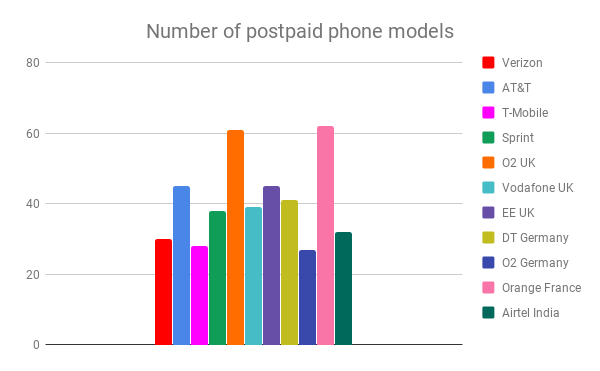
As you can see, the postpaid choice on Verizon is pretty pathetic in comparison with most carriers both home and abroad indeed, but we may have its legacy CDMA network to blame, and that one is being retired by the end of 2019.
T-Mobile has no such excuse but it does position itself as the discount and promo carrier so it strives to hit the value-for-money spot, as exemplified by its choice to be the first US network to officially sell the OnePlus 6T.
AT&T, on the other hand, is doing pretty well in postpaid choices, even though it, as all US carriers, suffers from the case of Huawei-titis and general Chinese brand malaise due to reasons beyond their will.

On prepaid, Verizon is doing better when it comes to phone choices
The Samsung-Apple market share duopoly
The average number of phones sold by carriers abroad is usually higher than on US carriers mainly because brands like Huawei, Sony, Xiaomi, Oppo or Nokia haven't gotten through to the American market for one reason or another. On the other hand, plenty of international carriers carry a much smaller number of LG phones compared to the US ones.
| Postpaid models (non-refurbished) | Prepaid models | |
|---|---|---|
| Verizon | 30 (Apple-11, Samsung-6, Google-3, LG-3, Motorola-3, Kyocera-2, Asus-1, RED-1) | 38 (Apple-13, Samsung-7, Motorola-5, Google-3, LG-4, Kyocera-1, Asus-1, ZTE-2, Reliance-1, Nokia-1) |
| AT&T | 45 (Apple-14, Samsung-13, LG-8, Motorola-1, Kyocera-1, Sonim-2, Alcatel-1, ZTE-1, RED-1, Razer-1, Cingular-1, BlackBerry-1) | 11 (Apple-4, Samsung-2, LG-2, Alcatel-1, ZTE-1, Cingular-1) |
| T-Mobile | 28 (Apple-9, Samsung-7, LG-6, Motorola-2, Alcatel-1, OnePlus-1, T-Mobile-2) | 27 (Apple-9, Samsung-7, LG-7, Motorola-2, Alcatel-1, OnePlus-1, T-Mobile-2) |
| Sprint | 38 (Apple-10, Samsung-10, LG-7, Motorola-4, Kyocera-3, Sonim-2, Alcatel-1, CAT-1) | As of 1/10/2019, Sprint Forward plans have been discontinued. |
| Vodafone UK | 39 (Apple-9, Samsung-10, Huawei-6, Sony-4, Google-2, Motorola-1, Palm-1, OnePlus-1, Nokia-1, BlackBerry-1, Vodafone-2, LandRover-1) | 22 (Apple-3, Samsung-2, Alcatel-4, Doro-4, Huawei-2, MobiWire-2, IMO-2, Palm-1, Nokia-4) |
| O2 UK | 61 (Samsung-16, Apple-12, Sony-9, Huawei-7, LG-3, Google-2, Motorola-2, OnePlus-4, Nokia-3, Alcatel-1, Doro-1, Honor-1) | 71 (Samsung-16, Apple-12, Sony-6, Huawei-5, LG-3, Google-2, Motorola-4, OnePlus-4, Nokia-6, Alcatel-7, Doro-4, Honor-1, ZTE-1) |
| EE UK | 45 (Apple-11, Samsung-10, Sony-5, Huawei-8, LG-3, Google-2, Motorola-1, OnePlus-1, Nokia-2, Landrover-1, EE-1) | 25 (Nokia-7, Alcatel-4, MobiWire-4, Samsung-2, Sony-2, Doro-2, Motorola-1, Huawei-1, EE-1, LG-1) |
| O2 Germany | 27 (Apple-8, Samsung-11, Sony-2, LG-1 Nokia-3, Razer-1, HTC-1) | 36 (Apple-8, Samsung-11, Huawei-9, Sony-2, LG-1, Nokia-3, Razer-1, HTC-1) |
| DT Germany | 41 (Apple-9, Samsung-7, CAT-5, Sony-4, Huawei-5, LG-2, Google-2, Doro-3, Nokia-2, BlackBerry-1, Alcatel-1) | 47 (Apple-9, Samsung-10, CAT-5, Sony-4, Huawei-9, LG-2, Google-2, Doro-3, Nokia-1, BlackBerry-1, Alcatel-1) |
| Orange France | 62 (Apple-10, Samsung-10, Huawei-10, Sony-4, Orange-4, Google-2, Doro-2, Nokia-1, BlackBerry-2, Motorola-2, Honor-1, Wiko-4, Crosscall-4, HTC-1, Honor-1, Oppo-2, Kapsys-1, Fairphone-1) | |
| Airtel India | 32 (Apple-10, Samsung-11, Google-4, Nokia-4, Oppo-1, Vivo-2) |
Apple started this trend by providing a record number of LTE band support with each and every iPhone iteration since the 5s, and we are now at the 27-band mark with the unlocked 2018 models, which the globetrotter or carrier hopper in you will surely appreciate. Samsung's Galaxy S and Note lines are not far behind, as the unlocked models sold on the US website can work with each US carrier out of the box, too.
If you want decent US carrier plan prices, go family or prepaid

When it comes to 4G/5G plan prices, though, the eventual merger of Sprint and T-Mobile could steer them either way in the long run, as there will only be a time-limited initial cap on plan pricing at the resulting new T-Mobile.
Needless to say, there are different perks involved with each carrier plan, and if you split the bill among four lines, the prices will be much lower but, overall, the US has one of the highest cell phone plan prices in the world, even against the fledgling 5G offerings.
Hey, for the price of Verizon's most premium line, UK's EE sees its unlimited 4G/5G offering, and raises it a brand spanking new Galaxy S10 5G. What do you think, is encroaching on the $100 mark for a single line out of whack as far as cell plan prices go?

EE UK - do you want a 5G phone for Verizon's plan pricing, too?








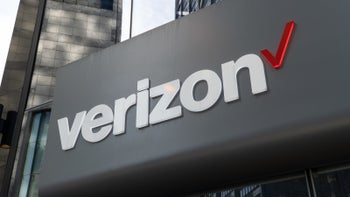

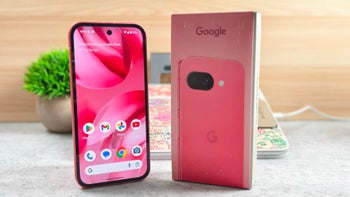
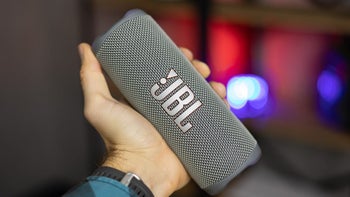
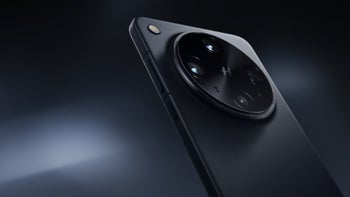
Things that are NOT allowed: